
Three days back, a colleague asked if I could write a piece on the Assam government’s crackdown on child marriages in the state. The colleague knows just enough about me: she’s opinionated and an Assamese woman from Guwahati. I guess that qualifies me to write this piece. As you read on, you will discover my politics and my worldview. This might serve as a warning and an assurance at the same time: this piece is not ‘neutral’. These are my thoughts, my beliefs, and are highly charged.
It was my second year studying sociology at Delhi University when I was introduced to sociology of gender. They say university is a space for unlearning, uncomfortable unlearning. Personal experience would point in the same direction. But as I read on and engaged in conversations with people who were nothing like myself, my core beliefs metamorphosed. This is around the same time, I first began questioning the ‘age of consent’. The first set of questions was: How was 18 decided upon to be the age at which people could consent? Was this decided arbitrarily? I thought so, since there was no apparent biological basis. Moreover, I was not convinced that the French matured faster since their age of consent was 15.
The next few concerns were even more difficult to resolve. It did not make sense to me how a 17 year old could not consent to sex on the eve of their 18th birthday. The 18th birthday could not be considered some exclusive magical rite of passage, undergoing which people could give uncoerced consent. This also drew my attention to the fact that when a certain age is arbitrarily decided upon, it articulates the message that people ageing above 18 could never be coerced into giving manufactured consent. Again, an idea that has proven to be untrue.
Assam’s government likes to call the crackdown on child marriage ‘neutral’ and believes that it is not against any particular group of people. But it would be interesting to first consider which people practise child marriage. People need not be inherently evil to do so. Individuals in societies often do not spontaneously decide to marry someone under the ‘legal’ age. Therefore, it must be a part of their shared habitus. Social practises are social by virtue of being structural, and not because they are individually practised by a large number of people. Thus, certain communities would practise certain practices by virtue of being the community. In such circumstances, it is evident that even if the government claims ‘neutrality’, it is virtually impossible. A crackdown will target only certain groups who practise child marriage. In this, it would also criminalise and villainise the same groups.
In their claim of neutrality, the government also fails to acknowledge the value of cultural relativism in a state like Assam which is far from being homogeneous. The government’s standard of neutrality is not neutral towards certain groups; it only works against them. In a pluralistic society, uniform law will forever work to disadvantage certain groups. And when this comes to the Assam government’s crackdown on child marriage, we are aware of which these groups are, in context of Biswanath, Barpeta, Baksa, Dhubri, Hojai, Bongaigaon, and Nagaon districts. Often, the Bengali Muslim men are criminalised, and attempts at saving Bengali muslim women from their men are made. The next important question is whether Bengali muslim women really need saving by the Sarma government. These women do not need saving by Sarma at all. There are multiple accounts of women like Chandni who were ‘child brides’, but were living a perfectly happy life, and now have lost the sole earning members of the family (The Quint). The government’s actions do not seem to be targeted at making life better for these women. At best, a whole generation of men are criminalised, and their wives left destitute with no earning sources.
I do not endorse manufactured or coerced consent. And I am absolutely disheartened by the rates of maternal and infant mortality in the state. However, the way Assam’s government has tackled the situation is chaotic and insensible. The government is trying to communicate that this is a simple case of young women waiting to be saved. But when the complexities of a social issue are not considered, and it is understood in a linear fashion, it invites more trouble than it claims to solve. The way to tackle forced marriages could have started with creating awareness among the people. This will also entail bringing out change at the grassroots through community engagement. Change has to come from within communities. If people, or the stakeholders of the issue, are not taken on board, if they do not see value in what the government is attempting to do, it only creates further distance between the state and its citizens. The distance antagonises the government and people begin to actively resist government actions. This is not desirable, and hence, the best course of action would be to pass the mike, rather than infantalising and victimising people whose social practices are different from ours.
Iram who hails from Assam is a sociology graduate, and currently a masters student in TISS.



